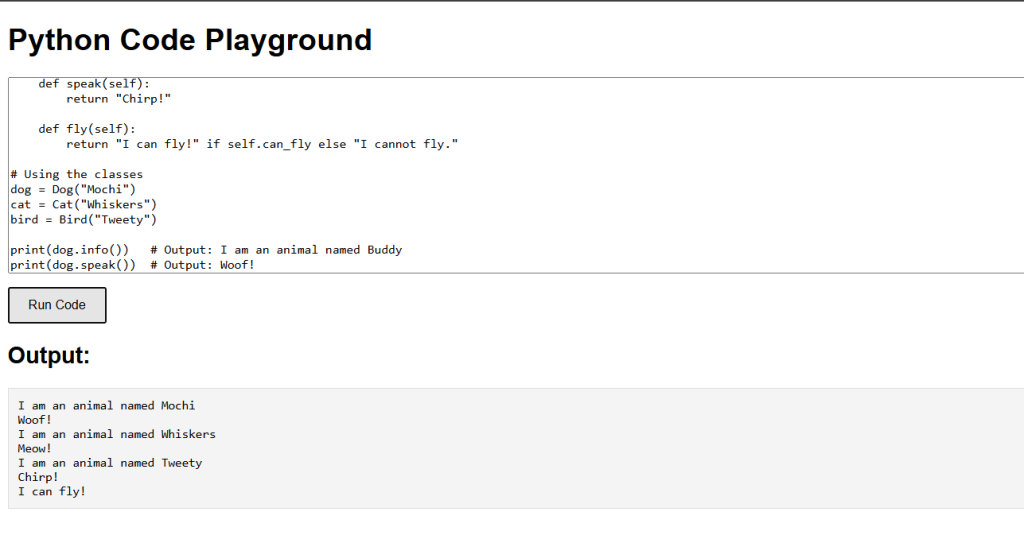Inheritance is a fundamental concept in object-oriented programming that allows you to create a new class (child class) that inherits attributes and methods from an existing class (parent class). This promotes code reuse and establishes a relationship between classes.
Creating a Parent Class
You define a parent class by creating a regular class. This class will serve as the base class for other classes.
In this example, the Animal class has an initializer (__init__), a method speak which must be implemented by subclasses, and an info method that returns information about the animal. A parent class is defined just like any other class in Python. It contains methods and attributes that can be inherited by child classes.
class Animal: def __init__(self, name): self.name = name def speak(self): raise NotImplementedError("Subclasses must implement this method") def info(self): return f"I am an animal named {self.name}"Creating a Child Class
You define a child class by specifying the parent class in parentheses after the class name.
Explanation: A child class inherits attributes and methods from the parent class and can override or extend them. The Dog and Cat classes inherit from the Animal class and provide their own implementation of the speak method.
class Dog(Animal): def speak(self): return "Woof!"class Cat(Animal): def speak(self): return "Meow!"Using the Child Classes
You can create instances of the child classes and use their inherited and overridden methods.
Instances of child classes can access methods and attributes defined in the parent class as well as their own methods.
dog = Dog("Buddy")cat = Cat("Whiskers")print(dog.info()) # Output: I am an animal named Buddyprint(dog.speak()) # Output: Woof!print(cat.info()) # Output: I am an animal named Whiskersprint(cat.speak()) # Output: Meow!Extending the Child Class
You can add new methods or attributes to a child class that are not present in the parent class.
Child classes can have additional functionality not defined in the parent class. The Bird class has an additional attribute can_fly and a new method fly, along with overriding the speak method.
class Bird(Animal): def __init__(self, name, can_fly=True): super().__init__(name) self.can_fly = can_fly def speak(self): return "Chirp!" def fly(self): return "I can fly!" if self.can_fly else "I cannot fly."bird = Bird("Tweety")print(bird.info()) # Output: I am an animal named Tweetyprint(bird.speak()) # Output: Chirp!print(bird.fly()) # Output: I can fly!Python Inheritance Example Code
This program creates an Animal class and its child classes Dog, Cat, and Bird. It demonstrates the inheritance of methods, overriding methods, and extending classes with new functionality.
class Animal: def __init__(self, name): self.name = name def speak(self): raise NotImplementedError("Subclasses must implement this method") def info(self): return f"I am an animal named {self.name}"class Dog(Animal): def speak(self): return "Woof!"class Cat(Animal): def speak(self): return "Meow!"class Bird(Animal): def __init__(self, name, can_fly=True): super().__init__(name) self.can_fly = can_fly def speak(self): return "Chirp!" def fly(self): return "I can fly!" if self.can_fly else "I cannot fly."# Using the classesdog = Dog("Mochi")cat = Cat("Whiskers")bird = Bird("Tweety")print(dog.info()) # Output: I am an animal named Buddyprint(dog.speak()) # Output: Woof!print(cat.info()) # Output: I am an animal named Whiskersprint(cat.speak()) # Output: Meow!print(bird.info()) # Output: I am an animal named Tweetyprint(bird.speak()) # Output: Chirp!print(bird.fly()) # Output: I can fly!

